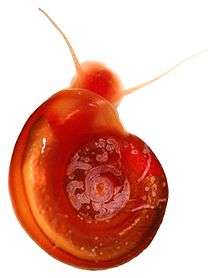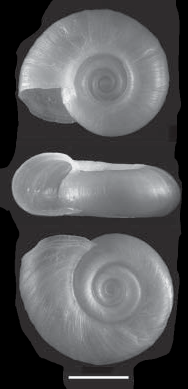Biomphalaria
| Biomphalaria Temporal range: Eocene–Recent | |
|---|---|
 | |
| An albino individual of Biomphalaria glabrata | |
| Scientific classification | |
| Kingdom: | Animalia |
| Phylum: | Mollusca |
| Class: | Gastropoda |
| (unranked): | clade Heterobranchia clade Euthyneura clade Panpulmonata clade Hygrophila |
| Superfamily: | Planorboidea |
| Family: | Planorbidae |
| Subfamily: | Planorbinae |
| Tribe: | Biomphalariini |
| Genus: | Biomphalaria Preston, 1910[1] |
| Diversity[2] | |
| 34 species | |
| Synonyms | |
Biomphalaria is a genus of air-breathing freshwater snails, aquatic pulmonate gastropod mollusks in the family Planorbidae, the ram's horn snails and their allies.
Biomphalaria is the type genus of the tribe Biomphalariini.
Taphius is a synonym for Biomphalaria.[3]
The shell of this species, like all planorbids is sinistral in coiling, but is carried upside down and thus appears to be dextral.

Species
There are 34[2] species in the genus Biomphalaria in total.
There are 22 American species:
- Biomphalaria amazonica Paraense, 1966
- Biomphalaria andecola (d'Orbigny, 1835)
- Biomphalaria cousini[4]
- Biomphalaria edisoni Estrada, Velásquez, Caldeira, Bejarano, Rojas & Carvalho, 2006[5]
- Biomphalaria glabrata (Say, 1818)
- Biomphalaria havanensis (L. Pfeiffer, 1839)
- Biomphalaria helophila (d'Orbigny, 1835)
- Biomphalaria intermedia (Paraense & Deslandes, 1962)[6]
- Biomphalaria kuhniana (Clessin, 1883)
- Biomphalaria obstructa
- Biomphalaria occidentalis Paraense, 1981[6]
- Biomphalaria oligoza Paraense, 1974[6]
- Biomphalaria orbignyi Paraense, 1975[6]
- Biomphalaria peregrina (d'Orbigny, 1835)[6]
- Biomphalaria prona
- Biomphalaria schrammi (Crosse, 1864)
- Biomphalaria straminea (Dunker, 1848)[6]
- Biomphalaria subprona (Martens, 1899) -
- Biomphalaria temascalensis Rangel-Ruiz, 1987
- Biomphalaria tenagophila (d'Orbigny, 1835)[6]
There are 12 species in the Old World (Africa, Madagascar and the Middle East):
- Biomphalaria alexandrina
- Biomphalaria angulosa Mandahl-Barth, 1957
- Biomphalaria barthi Brown, 1973
- Biomphalaria camerunensis
- Biomphalaria choanomphala
- Biomphalaria pfeifferi (Krauss, 1848)
- Biomphalaria salinarum Morelet
- Biomphalaria smithi Preston, 1910 - type species
- Biomphalaria stanleyi (Smith, 1888)
- Biomphalaria sudanica (Martens, 1870)
- Biomphalaria tchadiensis Germain, 1904
- Biomphalaria ruppellii Auet. - subspecies: Biomphalaria ruppellii ruppellii Auet.; Biomphalaria ruppellii katangae Haas
There is one known hybrid Biomphalaria glabrata × Biomphalaria alexandrina from Egypt.[7]
A cladogram showing phylogenic relations of (23 analyzed) species in the genus Biomphalaria:[8]
| Biomphalaria |
| ||||||||||||||||||||||||||||||||||||||||||||||||||||||||||||||||||||||||||||||||||||||||||||||||||||||||||||||||||||||||||||||||||||||||||||||||
| |
Distribution
The origin of the genus Biomphalaria is American.[8] The ancestor of Biomphalaria glabrata colonized Africa 2.3–4.5[8] or 2-5[9] millions years ago and speciated into all the African Biomphalaria species.[8]
Natural populations of these snails are usually found in tropical standing water or freshwater in South America and Africa, but they also reach 30° latitude in subtropical areas. Many species of these red-blooded planorbid snails (Gastropoda: Basommatophora) are able to survive a long time when removed from their freshwater habitat. Of the 34 Biomphalaria species, 4 (Biomphalaria glabrata, Biomphalaria pfeifferi, Biomphalaria straminea, and Biomphalaria tenagophila) have recently expanded their native ranges. They have been introduced to areas where other Biomphalaria species are endemic (e.g., Congo and Egypt) or to subtropical zones that have no frost period (Texas, Louisiana, Florida, Hong Kong).[2]
All species in the genus Biomphalaria except of native Biomphalaria obstructa has not yet become established in the USA, but they are considered to represent a potentially serious threat as a pest, an invasive species which could negatively affect agriculture, natural ecosystems, human health or commerce. Therefore, it has been suggested that this species be given top national quarantine significance in the USA.[10]
Parasites
This genus of snails is medically important, because the snails can carry a parasite of humans which represents a serious disease risk: the snails serve as an intermediate host (vector) for the human parasitic blood fluke, Schistosoma mansoni, that infects about 83 million people.[11]
The human disease schistosomiasis (aka snail fever) caused by all Schistosoma species (transmitted also by other snails) infects 200 million people.[12] The fluke, which is found primarily in tropical areas, infects mammals (including humans) via contact with water that contains schistosome larvae (cercariae) which have previously been released from the snail. Infection occurs via penetration of cercariae through the skin.
Eighteen species of Biomphalaria are intermediate hosts for Schistosoma mansoni; seven species of the genus have not been tested for this susceptibility and nine species are resistant.[8]
Altogether about 30 species of parasites from Africa and at least 20 species from the Neotropics are known to parasitize Biomphalaria.[8]
References
This article incorporates public domain text from the Majoros et al. reference.[2]
- ↑ Preston H. B. (1910) "Addition to the non-Marine Molluscan Fauna of British and German East Africa and Lake Albert Edward". The Annals and Magazine of Natural History including zoology, botany, and geology 6(8 series, 35): 526-. 535, plate IX figure 26, 26A.
- 1 2 3 4 Majoros, G. B.; Fehér, Z.; Deli, T.; Földvári, G. (2008). "Establishment of Biomphalaria tenagophila Snails in Europe". Emerging Infectious Diseases. 14 (11): 1812–1814. doi:10.3201/eid1411.080479. PMC 2630743
 . PMID 18976582.
. PMID 18976582. - ↑ Bouchet P.; Rocroi J.-P. (2005). "Classification and Nomenclator of Gastropod Families". Malacologia. 47 (1-2): 167–168.
- ↑ Teodoro, T. M.; Janotti-Passos, L. K.; Carvalho, O. D. S.; Caldeira, R. L. (2010). "Occurrence of Biomphalaria cousini (Mollusca: Gastropoda) in Brazil and its susceptibility to Schistosoma mansoni (Platyhelminths: Trematoda)". Molecular Phylogenetics and Evolution. 57 (1): 144–151. doi:10.1016/j.ympev.2010.05.019. PMID 20580934.
- ↑ Estrada, V. E.; Velásquez, L. E.; Caldeira, R. L.; Bejarano, E. E.; Rojas, W.; Carvalho, O. S. (2006). "Phylogenetics of South American Biomphalaria and description of a new species (Gastropoda: Planorbidae)". Journal of Molluscan Studies. 72 (3): 221–228. doi:10.1093/mollus/eyl003.
- 1 2 3 4 5 6 7 Rumi A., Gregoric D. E. G., Núñez V. & Darrigran G. A. (2008). "Malacología Latinoamericana. Moluscos de agua dulce de Argentina". Revista de Biología Tropical 56(1): 77-111. HTM.
- ↑ Yousif, F.; Ibrahim, A.; Abdel Kader, A.; El-Bardicy, S. (1998). "Invasion of the Nile Valley in Egypt by a hybrid of Biomphalaria glabrata and Biomphalaria alexandrina, snail vectors of Schistosoma mansoni". Journal of the Egyptian Society of Parasitology. 28 (2): 569–582. PMID 9707685.
- 1 2 3 4 5 6 Dejong, R. J.; Morgan, J. A.; Paraense, W. L.; Pointier, J. P.; Amarista, M.; Ayeh-Kumi, P. F.; Babiker, A.; Barbosa, C. S.; Brémond, P.; Pedro Canese, A.; De Souza, C. P.; Dominguez, C.; File, S.; Gutierrez, A.; Incani, R. N.; Kawano, T.; Kazibwe, F.; Kpikpi, J.; Lwambo, N. J.; Mimpfoundi, R.; Njiokou, F.; Noël Poda, J.; Sene, M.; Velásquez, L. E.; Yong, M.; Adema, C. M.; Hofkin, B. V.; Mkoji, G. M.; Loker, E. S. (2001). "Evolutionary relationships and biogeography of Biomphalaria (Gastropoda: Planorbidae) with implications regarding its role as host of the human bloodfluke, Schistosoma mansoni". Molecular Biology and Evolution. 18 (12): 2225–2239. doi:10.1093/oxfordjournals.molbev.a003769. PMID 11719572., text.
- ↑ Morgan, J. A. T.; Dejong, R. J.; Snyder, S. D.; Mkoji, G. M.; Loker, E. S. (2003). "Schistosoma mansoni and Biomphalaria: Past history and future trends". Parasitology. 123 (7). doi:10.1017/S0031182001007703./
- ↑ Cowie R. H., Dillon R. T., Robinson D. G. & Smith J. W. (2009). "Alien non-marine snails and slugs of priority quarantine importance in the United States: A preliminary risk assessment". American Malacological Bulletin 27: 113-132. PDF.
- ↑ Crompton, D. W. (1999). "How much human helminthiasis is there in the world?" (PDF). The Journal of Parasitology. 85 (3): 397–403. doi:10.2307/3285768. JSTOR 3285768. PMID 10386428.
- ↑ The Carter Center "Schistosomiasis Control Program". Accessed 20 November 2009.
Further reading
- Baker F. C. (1945) The molluscan family Planorbidae. Urbana, The University of Illinois Press, page 89
- (Portuguese) Brasil. Ministério da Saúde. Secretaria de Vigilância em Saúde. Departamento de Vigilância Epidemiológica. (2007) Vigilância e controle de moluscos de importância epidemiológica : diretrizes técnicas : Programa de Vigilância e Controle da Esquistossomose (PCE). Ministério da Saúde, Secretaria de Vigilância em Saúde, Departamento de Vigilância Epidemiológica. 2. ed. Brasília : Editora do Ministério da Saúde. 178 pp. ISBN 978-85-334-1438-9. (Surveillance and Control of Mollusks with Epidemiological Importance: technical directives: Schistosomiasis Control and Surveillance Program)
- Chapter: Aquaculture and schistosomiasis. In: Larsson B. (December 1994) Three overviews on environment and aquaculture in the tropics and sub-tropics. ALCOM (Aquaculture for Local Community Development Programme) Field Document No. 27, 52 pp.
- Plam, M.; Jørgensen, A.; Kristensen, T. K.; Madsen, H. (2008). "Sympatric Biomphalaria species (Gastropoda: Planorbidae) in Lake Albert, Uganda, show homoplasies in shell morphology". African Zoology. 43: 34–44. doi:10.3377/1562-7020(2008)43[34:SBSGPI]2.0.CO;2..